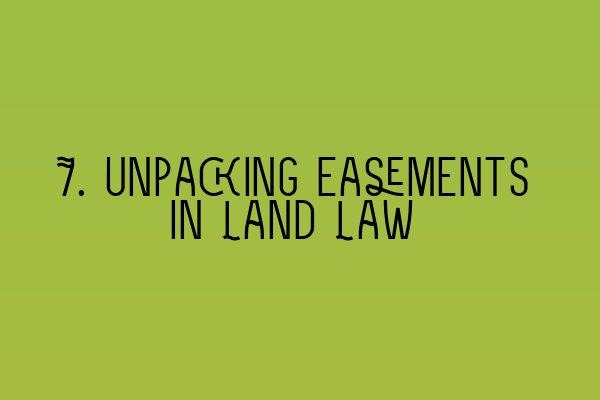Unpacking Easements in Land Law
When it comes to property law, there are various legal concepts and principles that need to be understood. One such concept is easements. In this article, we will take an in-depth look at easements in land law, discussing what they are, their types, creation, and termination. So, let’s dive in!
1. What are Easements?
Easements are rights that one person has over another person’s land. These rights are limited in scope and allow the holder of the easement (known as the dominant owner) to use the land owned by another person (known as the servient owner) for a specific purpose. Easements can be essential for landowners to access their property, use utilities, or enjoy other benefits.
2. Types of Easements
There are several types of easements, each serving a different purpose. Let’s explore the most common ones:
2.1. Right of Way
A right of way easement grants the dominant owner the right to pass through the servient owner’s land. This is often seen in situations where a landlocked property needs access to a public road.
2.2. Right to Light
Right to light easements protect a property owner’s access to natural light. This is particularly relevant in urban areas where buildings are closely located.
2.3. Right to Drain Water
In cases where neighboring lands are at different levels, a right to drain water easement allows water to flow from one property to another without causing damage.
2.4. Right to Use Utilities
These easements grant the dominant owner the right to use utility lines, such as gas or electricity, that run through the servient owner’s land.
3. Creation of Easements
Easements can be created in several ways, including:
3.1. Express Grant
An easement can be created through an express grant, where the servient owner willingly grants the dominant owner the right to use their land for a specific purpose. This grant is typically documented in writing.
3.2. Presumption of a Grant
In certain situations where there is evidence of continuous and apparent use of the servient owner’s land by the dominant owner, the law may presume the existence of an easement.
3.3. Necessity
An easement by necessity arises when a landlocked property has no other means of access to a public road.
4. Termination of Easements
Easements can be terminated in various ways, including:
4.1. Express Agreement
An easement can be terminated through an express agreement between the dominant and servient owners.
4.2. Merger of Title
If the dominant and servient properties are both owned by the same person, the easement is said to be terminated by the merger of title.
4.3. Abandonment
If the dominant owner voluntarily relinquishes their right to the easement and demonstrates intent to abandon it, the easement may be terminated.
These are just a few examples of how an easement can come to an end. The circumstances of each case may vary, so professional legal advice is essential.
Conclusion
Easements play a crucial role in land law, allowing for the provision of essential services and access to properties. Understanding the different types of easements, their creation, and termination is essential for both landowners and legal professionals.
If you are looking to expand your knowledge in property law or preparing for the SQE exams, make sure to check out our SQE 1 Practice Exam Questions and SQE 1 Practice Mocks FLK1 FLK2 to assess your understanding. For comprehensive preparation courses, we offer both SQE 2 Preparation Courses and SQE 1 Preparation Courses tailored to your needs. Stay updated with the latest SRA SQE Exam Dates and ace your exams with SQE Property Law & Land Law.
